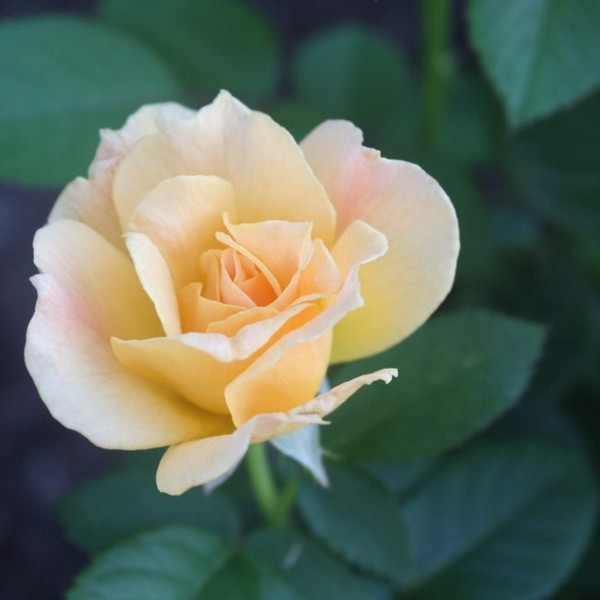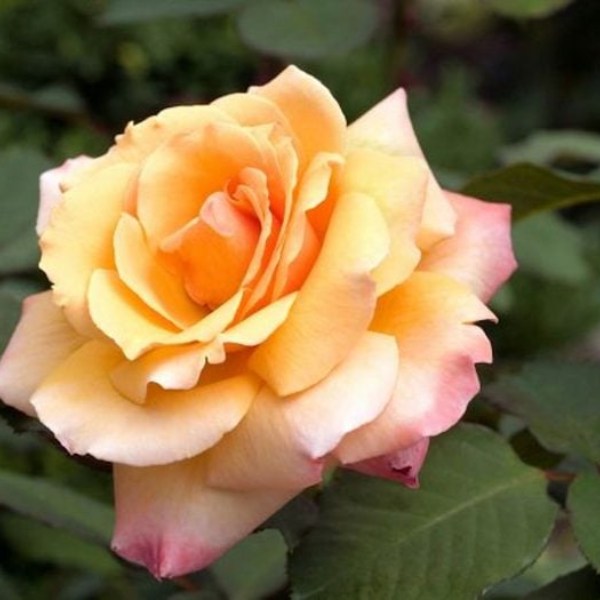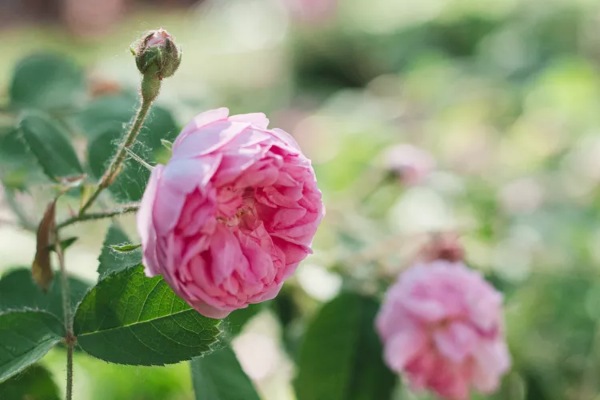Hybrid tea roses (Rosa x hybrida) are the product of a cross between old-fashioned tea roses and hybrid perpetual roses. They are differentiated by their large, high buds and tall, straight stems. The hybrid tea rose features long, pointed buds that open wide by unfurling little by little. Generally, hybrid tea roses only produce one blossom at the end of each stem and not clusters of flowers. Also, they have an open habit.
All hybrid tea roses are repeat bloomers throughout the growing season and produce some fragrance. These roses grow fast and reach their mature size of three to eight feet tall within three to four years. Their growth also depends on the variety and the growing conditions. They can be planted all year round, ideally in fall or early spring when they are still dormant.
Plant Attributes
- Common Name: Hybrid tea roses
- Botanical Name: Rosa x hybrida
- Family: Rosaceae
- Plant Type: Shrub
- Mature Size: 3-8 ft. tall, 2-3 ft. wide
- Sun Exposure: Full
- Soil Type: Loamy, well-drained
- Soil pH: Acidic
- Bloom Time: Spring, summer, fall
- Flower Color: All colors except true blue and black
- Hardiness Zones: 5-9 (USDA)
- Native Area: Cultivar, no native range
Also, Read 20 Ideas for Throwing a Fun and Memorable Baby Shower for Pregnant Women!
Hybrid Tea Rose Care
One thing you must know about hybrid tea roses is that they are bud-grafted onto hardy, disease-resistant rootstock. Their care needs are just similar to standard roses. They do well in full sun, regular fertilization, and ample moisture.

To plant one, dig a planting hole and spread the roots over a mound created inside the hole. Fill the hole with organically rich soil. If you’re from the northern climate, plant the graft union one or two inches deep in the soil. In southern areas, the graft should be just above the soil level. Be mindful to space the plants 24-36 inches apart for good air circulation.
Deadheading faded blooms to encourage more blooms. Take good care to properly overwinter your hybrid tea roses by providing enough moisture and protecting the graft. These plants can be attacked by various pests and diseases but are overall easy to care for.
Light
Hybrid tea roses thrive and do their best in full sun but will tolerate partial sun as well. Full sun exposure improves the plant’s blooming and general disease resistance.
Soil
These roses prefer acidic soil that ranges from 6.0 to 6.5 pH that is rich in organic matter. You should mulch the hybrid tea rose to cool its roots and conserve water and moisture. Give a two- to three-inch layer of mulch in the spring. If you live in warmer climates, only mulch the hybrid tea rose when its leaf bud starts to swell.
Water
Watering one or two inches of water per week is normally enough for a hybrid tea rose. However, this depends on the climate and growing conditions as well. If you’re growing this plant in hot climates and sandy soil, it will need more frequent watering than in cool coastal regions. The best way to water your hybrid tea rose is when the top three inches of the soil are dry. Water the soil and not the leaves to prevent it from catching diseases. Water deeply to increase root growth as strong and deep roots will encourage your hybrid rose to tolerate drought periods.
Temperature and humidity
The suitable temperature for a rose is 80.6° F. If your summers are humid, buy a mildew-resistant variety. If the summers are dry, get hybrid tea roses that can tolerate heat and have vigorous root systems.
Fertilizer
Hybrid tea roses love feedings and can thrive from the applications of fertilizers three times a year. You can start fertilizers at the beginning of spring, a month before new growth starts, or when you remove winter protection. Apply the second fertilizer during the first bloom period and the third application in mid to late July.
You should stop fertilizing about six to eight weeks before your first expected frost date to stop any damage to new growth when the temperature goes down.
Pick a balanced fertilizer or one designed for roses. If the soil’s pH is too high, then iron is essential. Bring an iron supplement in your fertilizer if the leaves turn yellow with green veins. An ideal fertilizer ratio for roses is 5-10-5 or 10-10-10 (the percentage of nitrogen, phosphorus, and potassium, respectively). You can also pay attention to Magnesium sulfate as it intensifies flower color, and deeper foliage color and encourages flowering canes.
Types of Hybrid Tea Roses
Hundreds of varieties of hybrid tea roses are available at nurseries and local garden centers. Here are a few picks for the top ten varieties of hybrid tea roses:
-
Peace hybrid tea rose
French horticulturist Francis Meilland developed this rose and sent cuttings to pals around the world as Germans started invading France. This hybrid rose got its name when peace was declared on VE Day in 1945. It has since been a garden special. This hybrid can grow up to 6 feet tall and 3 feet wide.

2. Mister Lincoln
All hybrid tea roses can easily catch diseases but Mister Lincoln in particular is more resistant than most. This stunning red rose gives an intoxicating fragrance. These roses look pretty in the garden or even in a vase.

3. Tahitian sunset
This award-winning hybrid tea rose has licorice-scented, multicolored blooms in a mix of yellow, apricot, and pink that become more intensely colored in full sun. This plant can grow up to 5 feet tall and 3 to 4 feet wide. It gives lush and healthy foliage and is good blackspot resistant.

4. Veteran’s honor
This jolly red hybrid is a great option for a patriotic display or a memorial garden to remember who lost their life during service. Veterans’ Honor blooms from late spring to late fall. The long-lasting cut flowers give a sweet raspberry fragrance.

5. John F. Kennedy
If you want a pure white rose that can tolerate summer heat in southern growing zones, this one is for you. Its dark green foliage helps elegant bloom look stunning in your garden. It also gives a strong fragrance.

Pruning
Pruning hybrid tea roses is nothing like pruning other roses. You can cut out dead, damaged, or infected canes less than a half-inch diameter at any time. The best time to prune your roses is in early spring just as new growth happens in late spring.
You should prune strong and healthy canes by almost a third of their length, down to 12 to 24 inches as that encourages stronger stems and larger flowers and accentuates the shapes of the plant. That will eventually direct more of the plant’s energy into producing flowers.
Common pests and diseases
While some variants of hybrid tea roses are disease-resistant, some are still susceptible to some diseases, like botrytis blight, black spot disease, and crown gall. These plants can attract insects like spider mites and Japanese beetles.
How to get hybrid tea roses to bloom
Hybrid tea roses are bound to bloom throughout the summer but many factors can affect the frequency of blooming. The best way to ensure that your plant blooms enough is by providing six to eight hours of sun a day. Enough water and fertilization also play a big role in blooming. Deadheading faded blooms will provide growth and more blooms.

Common Problems with Hybrid Tea Roses
Curling Leaves
This is caused by a viral infection and that leads to a downward leaf curl. You can treat it by destroying the affected roses.
Yellow Leaves
Normally hybrid tea roses are most susceptible to problems related to black spot disease which can cause yellowing leaves.
FAQs
Q: How long do hybrid tea roses live?
A: Hybrid tea roses belong to the early modern class of roses, meaning they typically live six to ten years. If you take good care of your rose, it can likely live longer.
Q: Can we grow hybrid tea roses indoors?
A: All rose varieties can grow indoors if you provide ideal outdoor conditions, such as in a greenhouse that receives plenty of sunlight.
Also, Read 10 Pest-Repelling Companion Plants for Roses
